3. Which factors can negatively affect the acoustics in your home studio?
One important realisation in dealing with negative influences on room acoustics is that all problems that may occur have the same cause: reflection! Whether the individual phenomenon is room resonances, flutter echoes, or overly long decay times, they are all reflections, i.e. sound being "thrown back" from the walls, ceiling and floor, and, more generally, all non-absorbent ("hard") surfaces.
Reflections are not necessarily a problem, but their potential to become so increases depending on a particular characteristic of the room. We are talking about room size here. Your average bedroom or living room should always be regarded as "acoustically small". The smaller a room, the more negative the effect of reflections on its sound. The mean path length sound has to travel in such rooms before meeting a surface is very short, and the sound waves retain almost all their energy in propagation. The first reflections are therefore practically undamped in comparison to the original sound, and they arrive at the mic or listening location with only little delay. These strong early reflections lead to specific distortions and must therefore be contained.
Comb Filter Frequency Response
Comb filter effect distortions result from strong initial reflections arriving at the listening or mic position with a very brief time lag (the reflected sound travels a slightly longer path) to the original sound and interfering with the latter. Cancellation occurs with a certain base frequency and at its odd-numbered multiples; addition occurs at the even-numbered multiples. The frequency response is reminiscent of the teeth of a comb when represented on a linear scale - hence the name of this effect. In the more useful logarithmic representation, the "teeth" crowd together ever more tightly with increasing frequency. The stronger the reflections are, the more pronounced this comb filter effect is. Thus, the closer to a wall you position your mic, the greater the resulting distortions. The same is true of your listening position in a mixing studio: the closer the walls and ceiling are to the listening position, the greater the distortion of the recording.
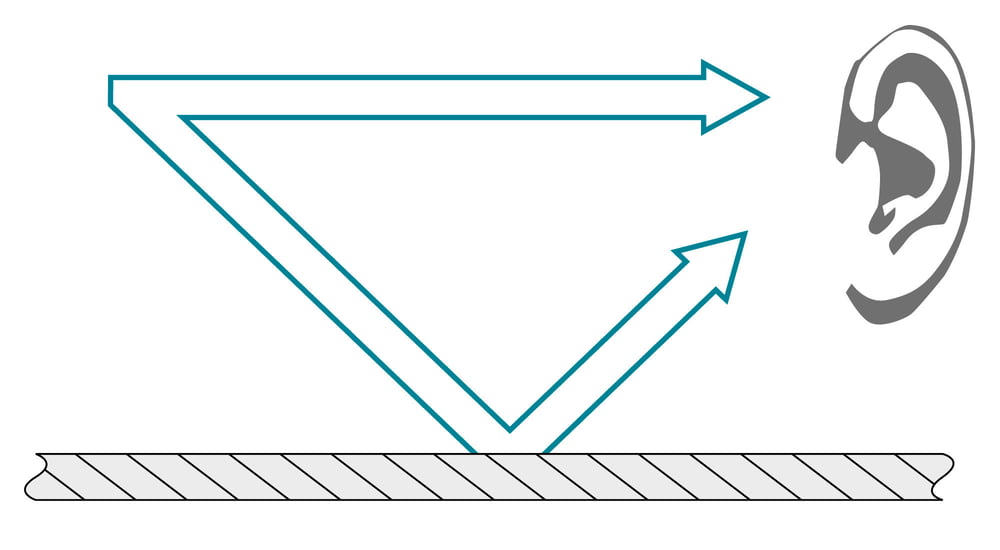
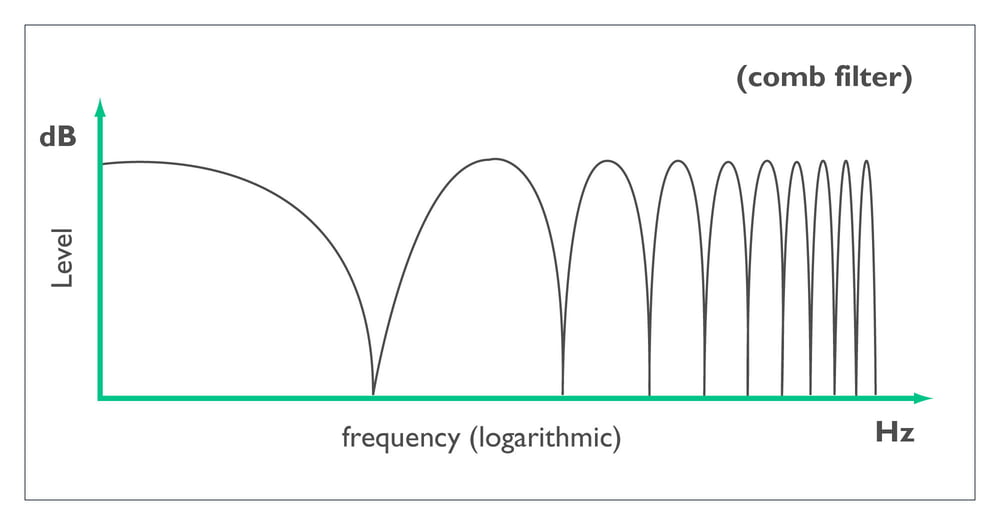
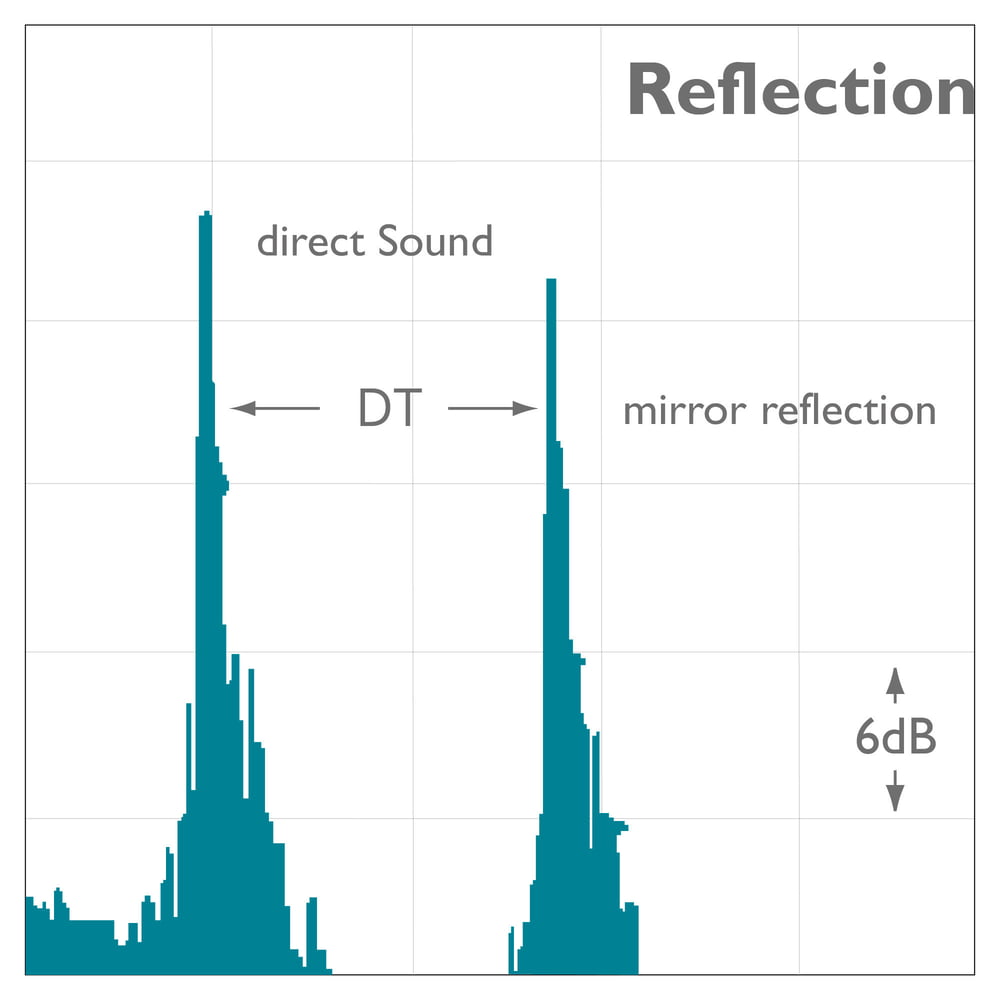
Room resonance/room modes
Room modes are standing waves, and their potential to interfere is especially strong in the bass range. Modes can be recognised as disruptive booming or droning sounds. Bass instruments may sound imprecise, sometimes insubstantial, sometimes exaggerated, depending on the note you play. Room modes occur whenever half a wavelength or one of its multiples of a sound wave at a certain frequency fits exactly between two limiting surfaces. This phenomenon is called "axial modes" (there are also weaker tangential and oblique modes, which involve not only two but four or all six limiting surfaces, respectively) and it results in stationary cancellations and additions (standing waves).
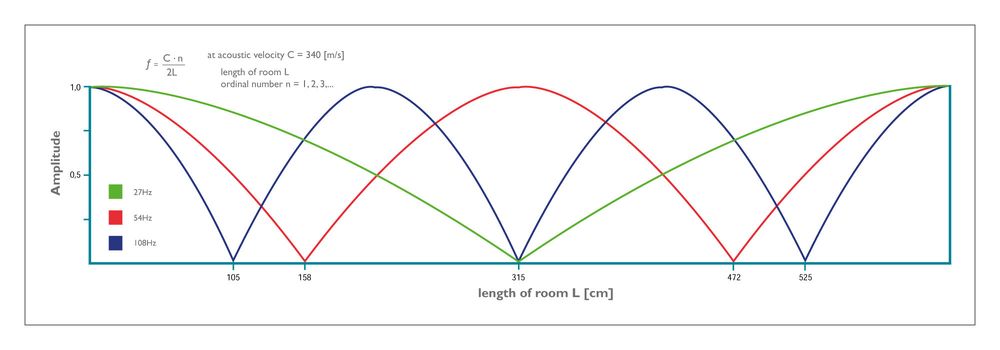
Room modes
Take as an example the deepest resonance frequency, with which you will always encounter very strong acoustic pressure directly in front of the walls and in the room's corners and edges. Towards the middle of the room, however, this frequency will almost completely cancel itself. Medium and high frequencies accummulate more and more resonance frequencies, increasing the resonance density so much that distortion ceases to appear. The figure above Shows another problem with modes. Since they are a phenomenon of resonance, they contain a great deal of energy, which takes some time to dissipate. With the lowest modes, the lingering booming and droning noise is easily recognisable.
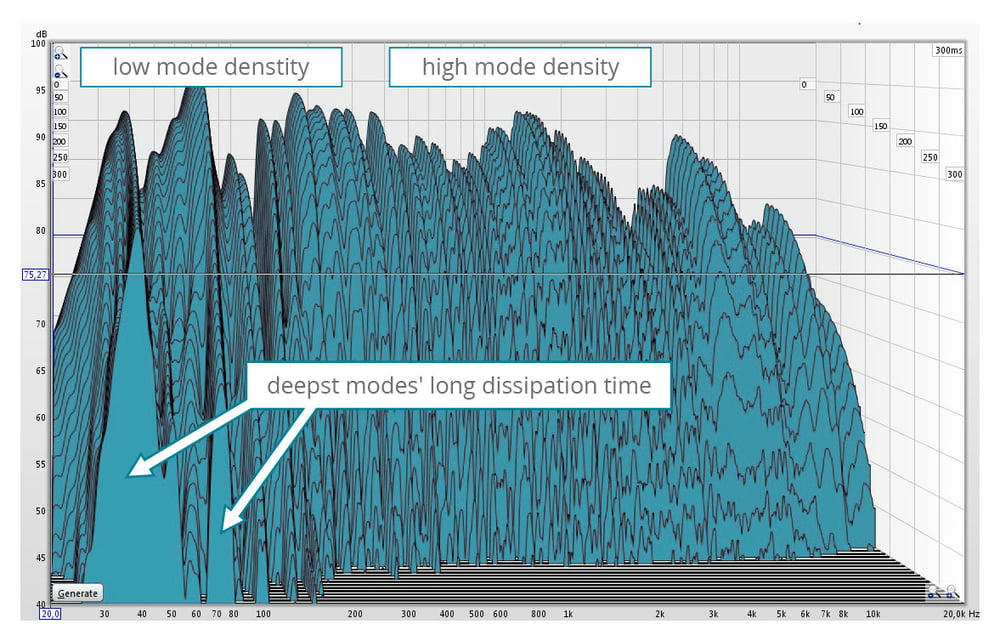
Mode density and dissipation behaviour of modes
Modes are especially distinct in small rooms with parallel limiting surfaces.
The worst locations are oblong/cuboid rooms with sides that are whole-number multiples of each other (e.g. 2 : 4 : 8). In rooms of the same relative dimensions, smaller rooms are more critical, as the resonance frequencies are particularly important in the fundamental tone range of music. Regarding room modes, living and basement spaces in contemporary residential buildings are a problem due to their low ceiling height. The typical ceiling height is 246cm; a person of average height's ears when sitting down will be almost exactly at half the room height. This means they'll be sitting in the area of minimum pressure for the deepest resonance frequencies and their odd-numbered multiples. Factory lofts and older tenement buildings are thus not only visually appealing, but also have acoustically beneficial properties.
Flutter echoes
Flutter echoes occur between parallel limiting surfaces when sound is percussively stimulated, for example when you clap your hands. The short acoustic pulse is thrown back by a "hard" wall and travels to the opposite wall only to be reflected towards the first wall once more. This is repeated in rapid succession until the sound energy has been fully absorbed. The closer these parralel walls are, the faster the reflections follow one another and the stronger are the resulting distortions. They manifest as metallic "boing" noises and are generated by the repeating sound pulses stimulating the higher-frequency room modes. If, in addition, the mode density is low in the medium frequency range, the stimulated modes result in distortions to the sound. The room's own deep resonance frequency will most likely not be stimulated, however, as this would require continuous stimulation. Flutter echoes are therefore a phenomenon prevalent in the medium frequency ranges. They become a nuisance mainly if the room has already been well dampened acoustically in other ways, i.e. when the decay time of the room overall is shorter than for the flutter echo by itself.
This, too, is a problem of small rooms in particular. Since the reflections need to pass through relatively little space, they rapidly encounter the next limiting surface and are reflected once more. With every reflection, the reflected sound loses some of its energy and thus decays after few reflections. This does not allow for a dense or diffuse sound field with even sound distribution to be generated. The sound receives a metallic tinge in such cases, which can be traced back to the time-delayed overlap of the direct sound with the few reflections (comb filter effect).
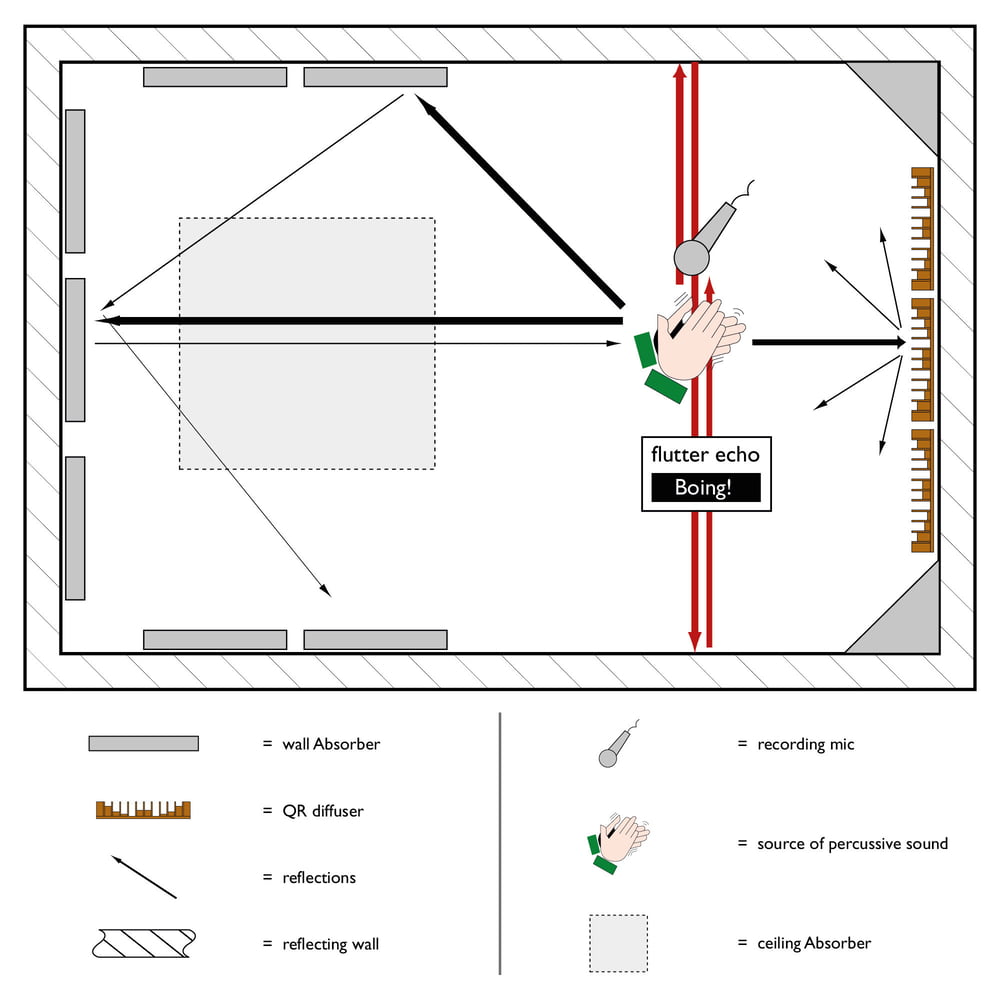
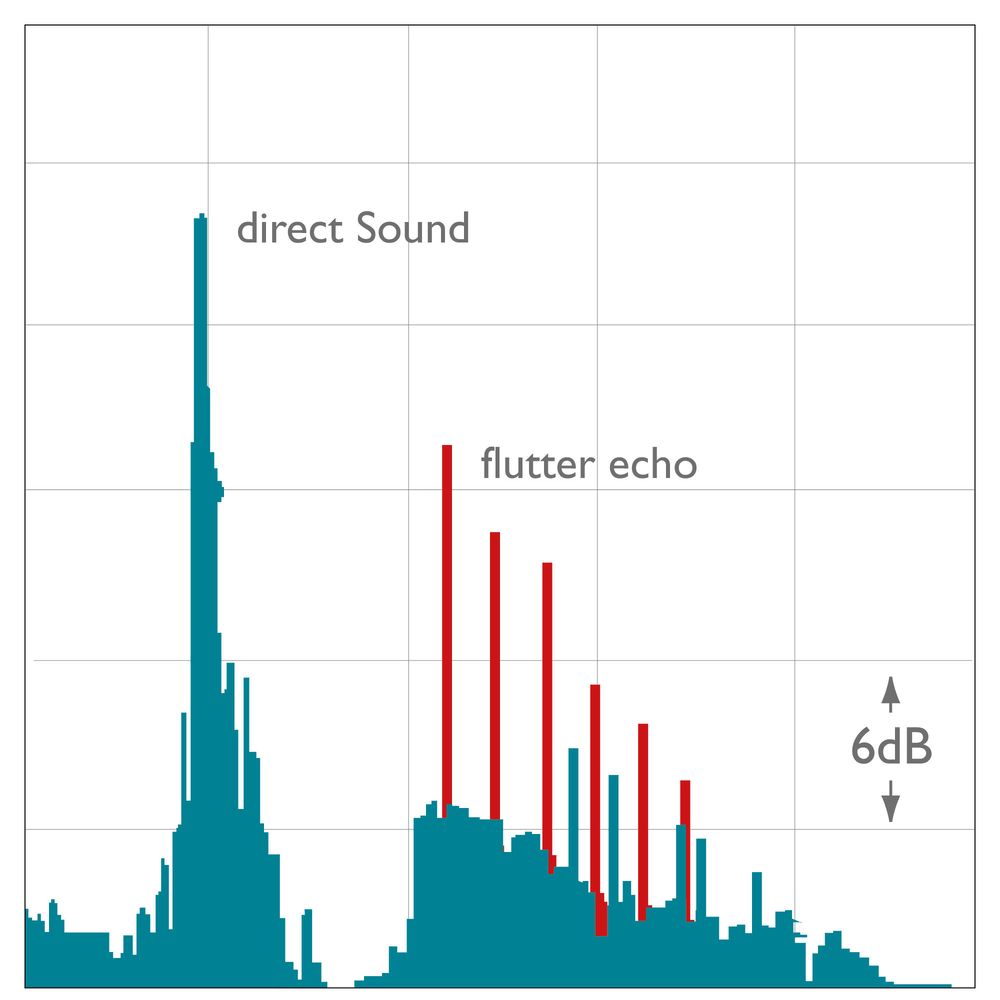
Different reverberation times for different frequencies (RT60)
Typically, the reverberation times of the different frquencies are very uneven in smaller rooms.
Deep frequencies' reverberation is characterized by distinct room modes. Medium and high frequencies are inconsistently reflected or absorbed, depending on the characteristics of the walls and/or furniture. Small rooms therefore often sound droning or tinny. Real reverberation, such as we are familiar with from large auditoriums or churches, for example, does not occur in small rooms. We should therefore more correctly talk of decay time rather than reverberation time.
Your Contacts
Product Highlights
Offers
-
Broadband Acoustic Absorbers
-
Bass Traps
-
Diffusors
-
Acoustic Treatment Sets
-
Miscellaneous Acoustic Treatment
Recommended categories
Do you like what you're seeing?






